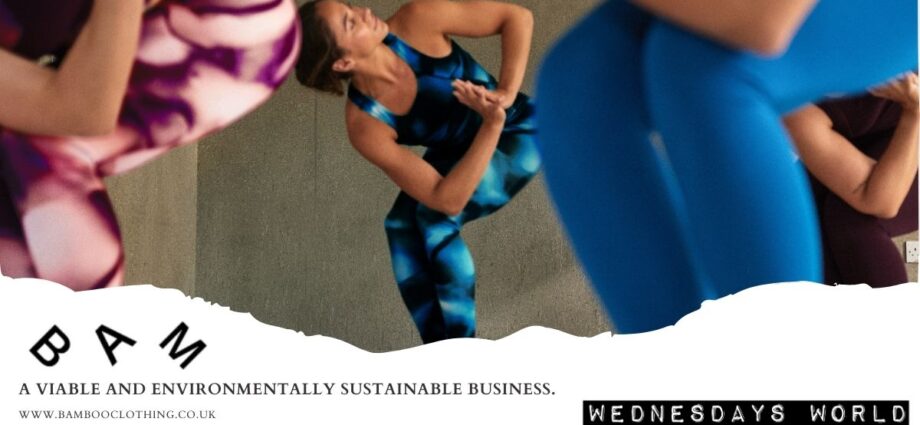BAM Bamboo Clothing stands at the forefront of this bamboo revolution, having built a comprehensive business model around this versatile material. Founded after an inspiring expedition to Greenland, BAM has evolved from a small start-up to a recognized leader in sustainable activewear with ambitious environmental goals.
What distinguishes BAM in the crowded sustainable fashion market is their holistic approach to sustainability—spanning materials innovation, supply chain transparency, and verified environmental impact measurement. Their B Corporation certification and impressive sustainability metrics validate their commitments beyond marketing claims.


BAM Bamboo Clothing: Expedition-Inspired Sustainable Activewear
Founded: 2006 by David Gordon, inspired by his man-haul expedition across Greenland
Sustainability Highlights:
- B Corporation certified with a score exceeding the minimum requirement of 80 points
- Three-pillar sustainability approach: People, Nature, Climate
- 95% bio-based, organic, or recycled fibers in current product range
- Goal to become “Impact Positive” by 2030
- Fair Wear Foundation membership ensuring ethical manufacturing
- Full supply chain traceability from bamboo sourcing to finished product
Materials & Sourcing: BAM’s primary material is bamboo sourced from Yunan and Sichuan provinces in China, where sustainable forest management practices are implemented. Their bamboo viscose process follows strict environmental standards through partnership with the ZDHC (Zero Discharge of Hazardous Chemicals) Foundation. Beyond bamboo, BAM incorporates other sustainable materials to reach their 95% bio-based, organic, or recycled materials goal.
Production Ethics: BAM maintains strong ethical standards throughout their production process. As a Fair Wear Foundation member, they ensure fair wages and safe working conditions across their supply chain. Their production focuses on:
- Worker welfare protection
- Safe chemical management
- Waste minimization
- Energy-efficient manufacturing


Sustainability Verification: BAM’s environmental claims are substantiated through multiple certifications:
- B Corporation Certification
- OEKO-TEX SteP certification for chemical management
- Fair Wear Foundation membership
- Zero Discharge of Hazardous Chemicals partnership
Price Range: $$ – Mid-range pricing that reflects quality sustainable materials and ethical production while remaining accessible. Product examples from their website show activewear items typically ranging from £40-105.
Where to Shop: BAM products are available through:
- Their e-commerce platform: BAM Bamboo Clothing
When compared directly with competitors, BAM holds the strongest sustainability perception among UK sustainable fashion brands:
Future Sustainability Roadmap


BAM has established clear sustainability goals for both mid-term and long-term horizons:
2025 Targets:
- 100% supply chain traceability
- Enhanced chemical management protocols
- Expanded certification coverage
2030 “Impact Positive” Vision:
- Net-zero greenhouse gas emissions
- Zero waste to landfill
- Zero pollution
- Zero wasted water
- Complete product circularity
This roadmap is supported by their Three Pillars approach (People, Nature, Climate) and includes specific initiatives like their 73 Zero circular range and transition to 100% recyclable or compostable packaging.
BAM Community & Consumer Engagement


Beyond products, BAM fosters community through:
- BAM Community membership program offering 10% off first purchases
- Regular updates on climate goals and sustainability progress
- Exclusive offers for members
- Educational content about sustainable choices
Their messaging is reinforced by third-party endorsements, including a testimonial from Ally Head, Senior Health Editor at Marie Claire: “BAM is one of my go-to sustainable activewear brands.”
Frequently Asked Questions About Bamboo as a Sustainable Material
Is bamboo truly sustainable compared to other natural fibers?
Bamboo is one of the fastest-growing plants on Earth, requiring minimal water, no pesticides, and regenerating from its own roots without replanting. These properties make it more resource-efficient than conventional cotton. However, the processing of bamboo into fabric (particularly viscose) involves chemicals. BAM addresses this concern through ZDHC partnership and proper waste management protocols.
What makes bamboo suitable for activewear?
Bamboo fabric offers natural properties ideal for activewear: exceptional breathability, moisture-wicking capabilities, temperature regulation, UV protection, and antibacterial properties that reduce odor. BAM’s product descriptions highlight these benefits with terms like “silly soft & breathable fabrics.”
How does BAM verify their sustainability claims?
BAM uses multiple third-party certifications including B Corp Certification, OEKO-TEX SteP, Fair Wear Foundation membership, and ZDHC partnership. Additionally, they implement product-specific tracking for metrics like water usage and emissions reduction, allowing customers to understand the impact of each purchase.
What is BAM’s approach to circular fashion?
BAM has developed their 73 Zero circular range, focusing on recyclable garments that can be processed at end-of-life rather than sent to landfill. They aim for complete product circularity by 2030 as part of their “Impact Positive” vision.
How transparent is BAM about their supply chain?
BAM provides full traceability on each garment, from bamboo sourcing in China’s Yunan and Sichuan provinces through processing and manufacturing. Their website includes dedicated sections on “Who Makes Your Clothes” and “Our Packaging” to provide supply chain transparency.

